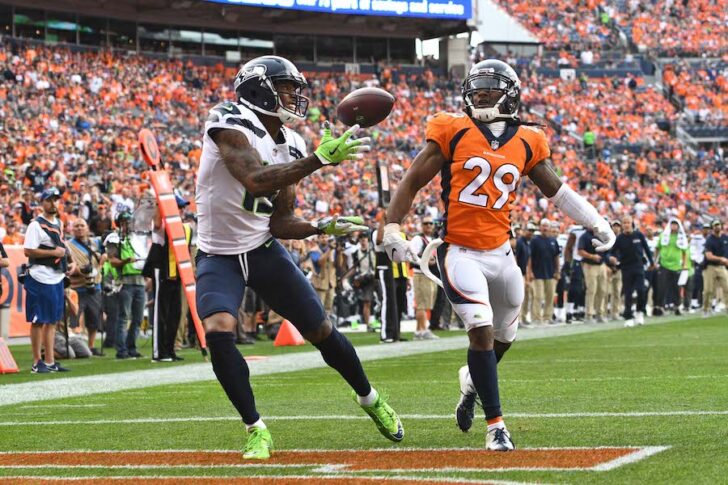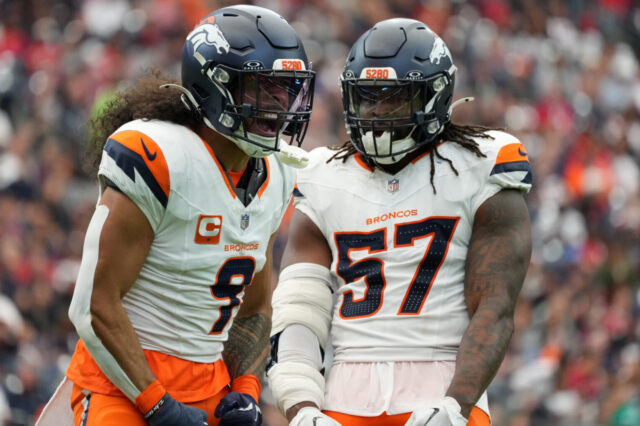Though it continues for the 12 teams in the playoffs, the 2018 season rests in the rear-view mirror for the Broncos and the other 19 teams to miss out on the playoffs.
Considering that, now is the perfect time to look at who improved, or raised their future stock the most, and who did the most damage to their own over the course of this painful season.
Three Up
1. Few, if any, players across the entire league improved their stock to the degree that undrafted rookie running back Phillip Lindsay did.
Lindsay wasn’t invited to last year’s combine and found himself undrafted this spring. 20 different running backs were drafted; two of those were even drafted by Denver. Entering training camp, Lindsay was listed as the fifth running back on the depth chart.
Yet, by the time Week 8 came around, Lindsay had managed to claw his way to the starting job.
Lindsay finished the season with the second-most rushing yards by an undrafted rookie in NFL history (1,037) and the ninth-most including veterans, the second-most rushing touchdowns by a rookie (9) and the seventh-most overall. Lindsay tied with fellow rookie Kerryon Johnson for the second-highest yards-per-carry average in the league (5.4) on his way to a Pro Bowl nomination. The nomination made the Denver local the first-ever undrafted rookie to make the Pro Bowl on the offensive side of the ball.
He will have to bounce back from the wrist injury he suffered late against the Raiders, but once he does, the sky’s the limit in 2019.
2. One of the major reasons Phillip Lindsay and the rest of Denver’s ground attack was much more effective than it had been in recent years was the offensive line. Thanks to the addition of tackle Jared Veldheer, promotion of guard Connor McGovern, and the improvement of tackle Garrett Bolles, the line was much better in both pass blocking and run blocking.
According to Pro Football Focus’ advanced analytics, Denver’s pass-blocking efficiency jumped from 26th and 30th in 2016 and 2017, respectively, to 17th in 2018. It’s by no means an elite line, but it’s no longer the team’s weakest point.
All of Denver’s offensive lineman have a run-blocking grade above PFF’s baseline of 60, and all but guard Ronald Leary have a pass-blocking grade above the baseline as well. Leary just misses out with a 59.9, but missed much of the season with injury. Last year, only center Matt Paradis, Leary and Bolles were above 60 in each category.
3. The inclusion of John Elway on this list may surprise some people, but it shouldn’t. Elway had a horrible 2017. His draft class was among the worst in the league, as just one player (Garrett Bolles) was active for all 16 games. Second-round pick DeMarcus Walker, fourth-round pick Brendan Langley, and fifth-round pick Jake Butt are the only other picks left with the team, though none of their productions have met expectations.
On top of all that, his good friend and then-head coach Gary Kubiak stepped down, which led to Elway hiring Vance Joseph, arguably one of the worst moves of his tenure as GM.
If it weren’t for Elway’s strong 2018 season, Joseph’s head may not have been the only one to roll on “Black Monday”.
Some of his 2017 moves (primarily the signing of defensive lineman Shelby Harris and Domata Peko Sr., and the draft selection of Garrett Bolles) began to look like hits, he improved the quarterback position, albeit only marginally, and most importantly of all, he had a great 2018 draft.
Bradley Chubb appears to be a superstar edge rusher, one of the most valuable defensive pieces when building a roster for today’s NFL. Courtland Sutton had an up-and-down rookie season, but flashed number one receiver potential. Royce Freeman showed good power and was among the better rookie running backs despite being overshadowed by Lindsay. Linebacker Josey Jewell and wide receiver DaeSean Hamilton were also major contributors. A draft class of this caliber is rare in the NFL, which just might have saved Elway’s job.
Three Down
1. Case Keenum‘s stock really could only go down after his fairytale 2017 campaign. After leading the Vikings all the way to the NFC Championship game, Keenum signed with the Broncos to be the starting quarterback. Keenum was an upgrade at the position for the Broncos, but still played poorly for much of the season.
One could argue that Elway overpaid for Keenum, and while it’s hard to argue that the upgrade between former starter Trevor Siemian and Keenum isn’t worth their difference in price, Keenum definitely isn’t overpaid, given the current market. The only quarterbacks paid less than Keenum – who aren’t in an equal or lesser quarterbacking tier – are either on their rookie deal or Tom Brady, who is only on that list because he has taken numerous pay cuts.
That doesn’t excuse Keenum’s play in 2018, though. After earning a career-high grade of 81.4 with the Vikings, Keenum regressed to the mean with a grade of 69.5. This ranks Keenum 27th among quarterbacks to appear in at least three games, behind the likes of Nick Mullens, Jameis Winston, and Ryan Fitzpatrick.
With no better alternative in sight, the Broncos will have to hope that either Keenum improves to 2017 form in his second season with the team, or that they hit a home run in the draft.
2. One of the biggest reasons for the Broncos’ collapse from Super Bowl champion to consecutive losing seasons is the decline of the secondary. The “No Fly Zone” is dead, and it will be a while until it is back, if it ever is.
When the Broncos traded cornerback Aqib Talib to the Rams, they did so because they believed that Talib was over the hill and that former first-round pick Bradley Roby was ready to take his place. Despite showing flashes of his high-end potential throughout this season, it is now clear that Roby wasn’t, and isn’t, ready to take over from a cornerback at the level of Talib. Roby’s overall grade of 59.9 and coverage grade of 58.6 was the lowest of his career. In fact, Roby had a coverage grade under 35 for three separate games this season.
The decrease of the secondary’s stock wasn’t all on Roby, though. Chris Harris Jr., who was having a near All-Pro caliber season, suffered a season-ending injury that sidelined him for the Broncos’ final four games.
What does that mean? With the Broncos’ best cornerback coming off a serious injury in his age-30 season, there is no clear ‘next man up’ in sight.
3. Although not as damaging to the Broncos’ season as the decline of the secondary and Case Keenum, no players tanked their stock to the level that safety Su’a Cravens and edge-rusher Shane Ray did. Following the 2015 NFL Draft, the hope was that Ray would become the dominant bookend to Von Miller on Denver’s defense. That all changed when Bradley Chubb was available at the fifth pick in this year’s draft.
From the moment the selection was made, it became clear that Ray was on his way out in Denver, but Ray certainly didn’t do himself any favors. According to PFF, his overall grade was the fourth-worst on the defense, and he wasn’t able to generate much of pass rush for the majority of the season. Despite pass-rushing being Ray’s only grade above PFF’s baseline, it still ranks 13th on the team, behind Denver’s seventh-round pick, linebacker Keishawn Bierria.
Cravens had a similarly poor season that landed him as the lowest-graded player on the Broncos. This is in large part to a coverage grade that is less than half of the disappointing Roby’s. These abysmal performances landed both players on the Broncos’ inactive list for the final three games of the season despite being healthy enough to play. It now seems like a longshot that either is a Bronco in 2019.



